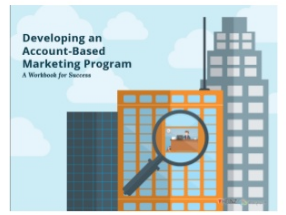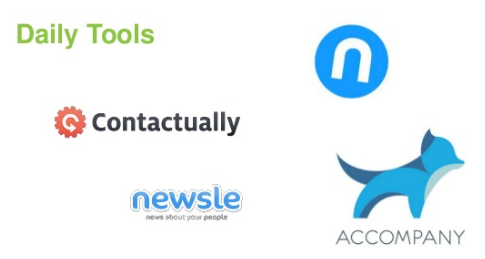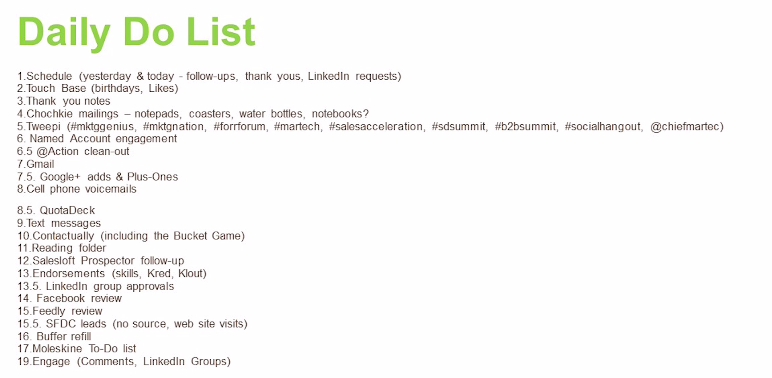1. Scripts and practice. My perspective on this is not just gonna come from the marketing side. We take a full funnel approach, so I’m gonna be talking to things relative to marketing and sales. When you’re starting a referral program, when you’re asking your sales people, your business development folks, and your customer service teams to generate referrals, to ask for referrals, you need to give them a script.
If you don’t give them an explicit script, they will not be able to ask for referrals in the way that you want them to. They won’t be comfortable with it. The main reason why sales people have call reluctance is because they are not comfortable and confident in what they’re about to say, and what they’re about to ask.
Not everyone is going to follow your script word for word, but if they have something to start with they can personalize its, and then they can practice it. We don’t give musicians a set of music and send them out to Carnegie Hall. We don’t hire professional athletes and send them right into opening day, so why do we give our salespeople scripts right when we are starting a referral program, and then at the sales kick off say, ‘off you go.’
Practice breeds familiarity and comfortability and confidence. Give your team scripts. Give them some starting points. Practice with them. Encourage them to practice with you, practice with their team, practice with their peers, to become better.
2. Never use the Linkedin Tool to generate referrals. Please don’t ever use the LinkedIn tool to generate referrals, like ever. LinkedIn is a fantastic tool, as you all know, to find out who you know, who other people know. It tells you where all the relationships exist. But no matter how strong that relationship, if you ask for a referral through LinkedIn’s tool, it will come across as cold. It will come across as spam-y. Use LinkedIn to find the information you need to figure out who knows who, and then go to a more natural channel. Use the phone, do it in person, send an email. Generate that referral in a far more natural way.
3. Read Joanne Black.
Joanne Black is an author and a blogger. She is based here in the San Francisco Bay area. I consider her the queen of referral selling. Her second to last book is called ‘No More Cold Calling’. Her last book is called ‘Pick Up the Damn Phone’. She’s really big on referral selling. This book, for me, is a treatise, I think that’s the right word, on referral selling. Great examples, great tactics. Highly encourage you to read this book when you are first starting a referral program, or if you already have one. There are implications in here, mostly for your sales teams, that I would encourage you to teach your sales team how to do, but great ideas for marketers as well to create a systematic way of generating a referrals in your business.
Referrals are not a random act kind of thing. Too often we think of asking our sales to get referrals, and so we’ll get it when you can. Joanne will teach you how to do this in a systematic way, so this becomes a much bigger, much more consistent stream for your business.
4. Read To ‘Sell Is Human’.
Another book that I recommend is ‘To Sell is Human’ by Daniel Pink. This to me might be the most important sales book written in the past ten years. Mainly because it takes the idea of selling, and makes it something that non-salespeople are comfortable with. We do a lot of training and best practice sharing with account management teams that do not want to be sellers.
They do not want to be cold calling. They do not want to be put in a selling environment. This book teaches examples of selling that aren’t about selling; they’re about real people connecting with real people about things they care about. When you can do that in an environment that doesn’t require you to close, you are in a much better place.
Quick example on this. We had one of our junior marketing people go to a conference last year. She’s an introvert, and she wasn’t really excited about doing a lot of the parties. She was terrified to talk about Heinz Marketing when she went to a cocktail hour. She was like, “How do I bring us up?” I said, “Let me make this really clear, and really easy: don’t!
Have a conversation with people about what they care about. Have a conversation that is fun and engaging for them, for you. You can talk about business later.” Daniel has a bunch of great examples in this book. It’s a quick easy read. Take a 2 and a half hour plane ride, and you’re done. For starting a referral program, I highly recommend that one.
5. Use values-added assets in your introductions.
I frequently get requests from BDRs, inside sales reps from organizations saying, “Hey, you’re a friend of our business. I notice you know so-and-so. Would you be willing to make an introduction?” I say, “Sure. I would be happy to make an introduction.
Can you give me a couple lines to make that introduction?” The lines they give me are, “Well we sell a widget, and the widget does this, and we do these features, and will you take a demo.” It drives me nuts. I’m not comfortable making that introduction if I don’t really know if they need that, right? If you’ve got some kind of an asset to offer and to show, it makes the referral that you are asking for much more appealing.

This is the front page of an ABA workbook that we did with a company called Integrate. It is a step by step tactical tool that can show you how to implement an ABM.
If you have a best practice guide, or if you have a recording of video from something like an event like this— you’ve got something of value that you can give someone that they can share on your behalf to make the referral—then you still get the introduction, but you do it in a softer way. You make it easier for those referring you, and make it more comfortable to do so. They are far more likely to do it if you provide materials for them to use.
6. Outro.
If you’ve heard of Quota Deck, it’s the same company, they just re-branded earlier this year. With this tool, basically you can go onto Outro, create a profile, and tell them what kind of people you want introductions to, and what kind of business you want to do. Other people will go onto this network and do the same thing.
You all say, “Here’s what I do, here’s what I’m interested in.” They will make connections for you. They will matchmake based on your common interests and common requirements. They will either give you introductions that you can then make on your own, or you can make it so that it is automated. Literally while you are sleeping, your sales reps can be generating referrals for themselves. Just like any lead source, some of those referrals are better than others. It’s a common source, built on common interests.
I’ve been using this in my business for a while, and it’s given us a good volume of leads, and actually some good introductions and opportunities. Probably a good tool from a sales enablement standpoint for your sales team, but I like it a lot
7. Make yourself more share-able.
This encompasses a lot of different things. What is something that you can actually be known for, that people want to share you about? Be known for something that makes you memorable, that makes you share-able. If you go to my bio on our website, you’ll see that I live on a 105 year old farmhouse with chickens. I talk about chickens a lot.
You go to my Instagram feed, you’re going to see a lot of pictures of my kids, a lot of pictures of BBQ chicken. Those kinds of things make us human. They make us more memorable. If all you are is your business, if all you are is what you’re selling, that’s not as interesting. That’s not as memorable.
Make yourself someone that people care about. Humanize yourself. I think Jay [Baer] or Joe [Chernov] talked about this this morning: I’ve never met a building that writes a check. It’s people that write checks. People that are not always making logical decisions. We’re making emotional decisions. We’re not always choosing things that are the best. Sometimes we’re choosing things because they are our favorite.
That relates to B2B buying. It relates to relationships. It relates to referral programs. Make yourself more share-able. Help your sales reps to understand what this means, and help them learn to make themselves more share-able. Allow them to be someone that can relate to another human beyond just being a sales rep.
If you’re making an outbound phone call, we encourage salespeople to use a 3-by-3 method. Take up to 3 minutes, and find up to 3 things that you can connect with that person about. If there are things you have in common, great. You both love the Chicago Cubs, you both have chickens. Maybe they were an Olympic rower, and you didn’t do that at all, but you’re curious about it. Make yourself interesting, make yourself more share-able.
8. Use every department in your organization—and theirs.
Your best referrals aren’t always going to come from your sales people, or their salespeople. They’re not always going to come from Chris here at Intuitive. Chris is a great guy. Chris knows a lot of people. Maybe Chris’ accountant is actually married to the best friend of the person that runs marketing for my dream client. It’s better to leverage the entire organization and figure out who has those relationships.
You don’t need a referral to the decision-maker. You don’t need a referral always to the person who is going to write the check. You need the door opened. The same reason why you don’t always need a referral based on your product and service, and the fact that you want to show someone a demo. Give them something of value. Connect based on some mutual interest to get in the door.
9. Be more aggressive with LinkedIn connections.
If you’re going to use LinkedIn as a way of understanding where the connections are, if you’re going to use LinkedIn as a means of understanding who knows people that you know, people that you want to get introductions to, then you need to get your company networked to LinkedIn.
A very simple trick for you and for everyone on your team: every morning, look at your calendar from yesterday, and look at all the people you met with. I guarantee you, if you look at that on a regular basis, you will find people that you assume you are connected to, but you’re not. If you don’t have that connection, you can’t see where your mutual connections are. The more actively you can do that, the better off you’re going to be.
10. Be precise about requests.
If I go to Chris and say, “Hey Chris. You love what we do, right? You love what we do, right? Can you make some referrals to us, like every once in awhile? When people need marketing help, can you make referrals?”
He’s gonna say okay cause he’s a nice guy, but he’s going to leave this room and forget, because that was a very generic and ambiguous request. If I go to Chris and say, “It looks like you know Joe at Acme Corp. How well do you know Joe? Would you mind making an introduction to Joe for me?”—that is a specific request. I have given him a task. I have given him something specific that he can do, that I want, that he can check off from his list. That is a much strong way to power your referral program.
11. Be more generous.
Anytime you’re giving a referral, anytime you’re introducing someone from your network, you’re putting your own reputation on the line. The people referring you know that as well. You need to have a reputation of giving beyond the ask and of giving people more than they expected–not just a demo. When Chris knows that he’s going to introduce me to someone, he knows I’m going to give them more than time than they expect.
I’m going to answer every question they have. I’m going to be an open book of ideas and best practices to give them. I’m making a good impression on that person. I’m reflecting well on Chris. Chris is far more likely to use me as a referral source again. This takes a little extra time and it takes a different mindset than just saying, “Well, time is money, and I can’t do this.” It requires a bit more of an investment.
We’ve all been in situations where we have seen people who are generous. People that give more than they expect. They stand out. These are people that not only get higher conversions on their referrals, but these are people that get more referrals. The have a more successful referral program overall.
12. Thank you notes.
Not thank you emails. Not thank you Facebook. Not thank you text, but notes. Handwritten notes. If you’ve seen my penmanship, you know that that is a terrible idea for me to do myself. Thankfully there is a company calledMaillift. There is a handful of companies that do this. I prefer Maillift. It’s a company out of Austin. You can either do this right within Salesforce, or you can send them an email template.
They have, I cannot even make this up, they have a team of retired school teachers that will write your letter for you. They will write it. You can pick the stationary, they’ve got a bunch of examples. It looks like something I might have written. Literally, I’ve got an email template that I can send them. I can do it from a plane without WiFi.
They send this letter out. I can’t tell you how big of an impression that makes. It’s just like sending an email, but if you’ve got some note cards, and your penmanship is better than mine, send a quick note. Send a thank you note for dumb little things that people wouldn’t expect. It makes a huge impression.
13. Leave voice mails.
This isn’t even about asking for the referral. This is just about setting up the referral. You have to build the relationship before you need it. If you wait to build a relationship, and wait to build credibility and build a reputation until right when you need the referral, you’re less likely to get it. When you leave a voicemail, you’re not expecting people to return the voice mail. You’re expecting them to hear your voice. There is science behind how important, and how impressionable, people are when they hear your voice versus just seeing your voice in text. It is very, very important.
14. Follow-up.
This is a simple topic. Just do what you say you’re going to do. When you take notes during conversations, every morning, look at your notes from yesterday. Look at all the checkboxes that are unchecked. Make sure that you follow up with people. Even if it’s just to tell them you are about to do what you said you’re going to do. Accountability is so important in building that reputation, in building that trust that can generate you more referrals.
15. Be synonymous with something.
This is a picture of Kraig Kleeman. He calls himself ‘The World’s Greatest Cold Caller’. We can spend another 15 minutes debating whether or not that is true, but that is his theme. When you think of cold calling there’s a couple people I think about. I think of Wendy Weiss, who calls herself ‘The Queen of Cold Calling’, and I think of Kraig Kleeman, who calls himself ‘The Greatest Cold Caller in the World’. You may not decide to be that bold, but is there something specific you become known for? That your company is known for? That you’re known for? That your sales team is known for that makes people think of you right away when they’re interested in giving a referral?
16. Daily tools.
There’s 4 of them that I’m using on a daily basis. Some of them overlap with each other. All of these are looking at my network. They’re looking at my calendar, and they’re reminding me to follow-up.

1. Newsle, which I think just re-branded 2 days ago to ‘LinkedIn in the News’, or something like that, is looking at all my first connections, and telling me who is in the news, and who was quoted in a press release. Who was published somewhere?
2. Contactually: I can tell Contactually that I want to talk to this group of people every 2 weeks, this group of people I want to talk to once a month. Every morning, Contactually will tell me all the people I’m out of band on. They look at my email, my CRM, my social channels. If I wanted to be in touch every 2 weeks, and it’s been 15 days, they tell me. It’s my safety net.
3. The N is for a company called Nudge. Nudge was founded by a couple former Eliquo people. It’s amazing the Eliquo community now has all these other startups. They’re doing great, great work.
4. Accompany is a tool that works for you to accumulate and organize personal details about all of your contacts, to help make maintaining human connections much easier. Before meeting with someone, you can view their profile in your account and refresh your memory on the specifics of their professional history, their family, and their recent life events. This helps you engage in personal, genuine conversation each time you meet up with any of your contacts, no matter how many contacts you have.
17. Daily do list.

I mentioned things you’re doing every morning. This is my list every morning at 7:30. There is a handful of things I am reminding myself to do. It’s follow-up with people. It’s sending thank you notes. I’m using tools to ask for referrals. To follow-up with referrals. And also giving referrals. If you want to get more referrals, you have to give referrals. You have to be generous with your own network as well (that should be #23 on this list).
18. Use excuses to reach out.
Someone’s birthday. They got a job promotion. Little things make a big difference.
19. Respond to every birthday message.
On your birthday, I would encourage you to block off 2 to 3 hours, if you can to respond to every single birthday message. Every birthday message is someone giving you their attention, and it’s mostly people that you haven’t talked to in a while. You don’t have to reply back and ask for a referral, but reply back and ask something to engage conversation. Every year on my birthday, I generate new pipeline for my business. Simply by responding to birthday messages—it’s unbelievable. Not even by trying to do it.
20. Free samples.
We talked about being generous. Offer samples of your ideas. Offer samples of what you’re doing. Make people walk away with some value. When we talked inside sales team I tell them, when your prospect looks up from that first phone call, I want them to lean back in their seat and say, “Wow, that was awesome. I would have paid for that.” What is that for you? What is that for your business? What is that for the value prop you’re trying to create?
21. Write more letters.
I’ve talked about my past through writing more letters. Could be for any particular reason.
22. Lead with the problems you solve, not what you do.
If you’re at a networking event, and someone asks you what you do, pretend they asked you the question, “What do you do for your customers?” Answer that question, because that’s really what they want to hear. That’s what they want to know. That will lead you to a better conversation, and it’s going to help you in the long run.

